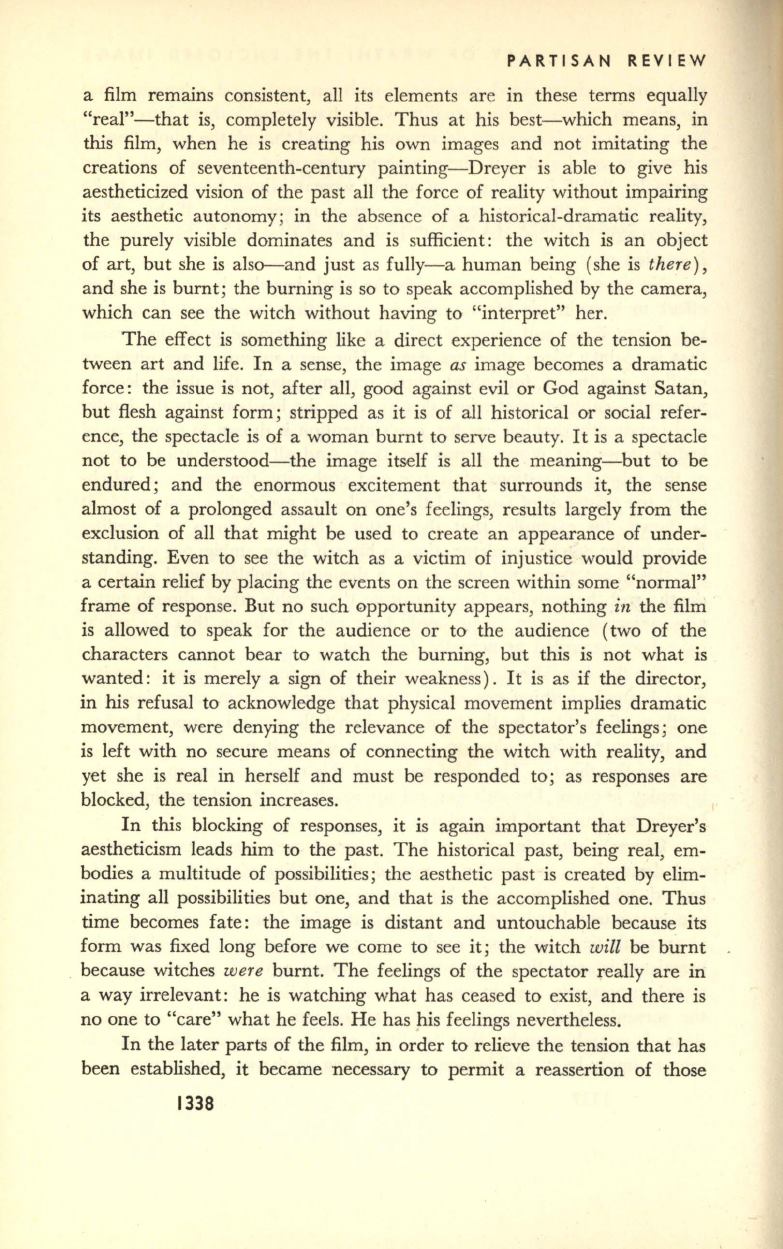
PARTISAN REVIEW
a film remains consistent, all its elements are in these terms equally
"real"-that is, completely visible. Thus at his best-which means, in
this film, when he is creating his own images and not imitating the
creations of seventeenth-century painting-Dreyer is able to give his
aestheticized vision of the past all the force of reality without impairing
its aesthetic autonomy; in the absence of a historical-dramatic reality,
the purely visible dominates and is sufficient: the witch is an object
of art, but she is also-and just as fully-a human being (she is
there),
and she is burnt; the burning is so to speak accomplished by the camera,
which can see the witch without having to "interpret" her.
The effect is something like a direct experience of the tension be–
tween art and life. In a sense, the image
as
image becomes a dramatic
force: the issue is not, after all, good against evil or God against Satan,
but flesh against form; stripped as it is of all historical or social refer–
ence, the spectacle is of a woman burnt to serve beauty.
It
is a spectacle
not to be understood-the image itself is all the meaning-but to be
endured; and the enormous excitement that surrounds it, the sense
almost of a prolonged assault on one's feelings, results largely from the
exclusion of all that might be used to create an appearance of under–
standing. Even to see the witch as a victim of injustice would provide
a certain relief by placing the events on the screen within some "normal"
frame of response. But no such opportunity appears, nothing
in
the film
is allowed to speak for the audience or to the audience (two of the
characters cannot bear to watch the burning, but this is not what is
wanted: it is merely a sign of their weakness) .
It
is as if the director,
in his refusal to acknowledge that physical movement implies dramatic
movement, were denying the relevance of the spectator's feelings; one
is left with no secure means of connecting the witch with reality, and
yet she is real in herself and must be responded to; as responses are
blocked, the tension increases.
In this blocking of responses, it is again important that Dreyer's
aestheticism leads him to the past. The historical past, being real, em–
bodies a multitude of possibilities; the aesthetic past is created by elim–
inating all possibilities but one, and that is the accomplished one. Thus
time becomes fate: the image is distant and untouchable because its
form was fixed long before we come to see it; the witch
will
be burnt
because witches
were
burnt. The feelings of the spectator really are in
a way irrelevant: he is watching what has ceased to exist, and there is
no one to "care" what he feels. He has his feelings nevertheless.
In the later parts of the film, in order to relieve the tension that has
been established, it became necessary to permit a reassertion of those
1338


